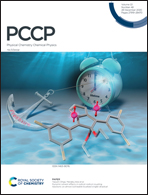Extended conjugation of ESIPT-type dopants in nematic liquid crystalline phase for enhancing fluorescence efficiency and anisotropy†
Abstract
Organic compounds capable of excited-state intramolecular proton transfer (ESIPT) show fluorescence with a large Stokes shift and serve as solid-state emitters, luminescent dopants, and fluorescence-based sensing materials. Fluorescence of ESIPT molecules is usually increased in the solid state, but is weak in solvents due to the accelerated non-radiative decays by rotational motions of a part of the molecular core in these environments. Here we report, using a representative ESIPT motif 2-(2-hydroxyphenyl)benzothiazole (HBT), the extended-conjugation strategy of keeping sufficient fluorescence efficiency both in the solid state and in organic media. The introduction of an alkyl-terminated phenylene–ethynylene group into the HBT molecule dramatically enhances the fluorescence quantum yield from 0.01 to 0.20 in toluene and from 0.07 to 0.32 in a representative room-temperature nematic liquid crystal, 4-pentyl-4′-cyano biphenyl (5CB). The newly-synthesized CnP-C![[triple bond, length as m-dash]](https://www.rsc.org/images/entities/char_e002.gif) C-HBT (n = 5 or 8) serves as a fluorescent dopant in 5CB and exhibits anisotropic fluorescence with the order parameter of 0.48, where the luminescence is controlled by the applied electric-field. The enhanced emission efficiency is rationalized by the larger height of energy barrier for the ESIPT process due to the introduction of phenylene–ethynylene groups.
C-HBT (n = 5 or 8) serves as a fluorescent dopant in 5CB and exhibits anisotropic fluorescence with the order parameter of 0.48, where the luminescence is controlled by the applied electric-field. The enhanced emission efficiency is rationalized by the larger height of energy barrier for the ESIPT process due to the introduction of phenylene–ethynylene groups.



 Please wait while we load your content...
Please wait while we load your content...